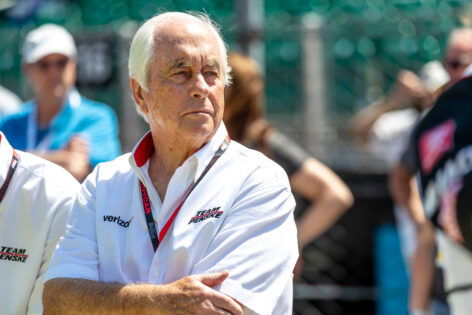The horsepower and aero argument in NASCAR isn’t new, but the volume just cranked to 11 this year. Denny Hamlin has pleaded for NASCAR to “unstick” the cars, calling them “so planted… stuck to the race track” while urging more drag and power to spark passing opportunities. Meanwhile, Kevin Harvick and Joey Logano have joined the chorus, with Harvick famously tweeting, “Put some damn power in current NASCAR cup cars,” and Logano demanding real bite: “We want more power… It’s more b—–.”
But now, a driver from NASCAR’s most buttoned-down, powerhouse team, Team Penske, has decided to weigh in with a crisp 8-word verdict that’s sharp enough to turn heads. Let’s just say he doesn’t tiptoe around the topic.
Ryan Blaney takes aim at Cup package
Under the current Next Gen rules, Cup Series cars run at 670 hp on most tracks, dropping to 510 hp on superspeedways like Daytona and Talladega. That 670 hp figure is designed to balance power and control while keeping speeds in check. By comparison, Xfinity cars produce 650-700 hp unrestricted, almost the same raw output, but with noticeably more wheel-to-wheel chaos. And that’s why many drivers argue it’s a compromise that’s too tame.
In a conversation with The Athletic, Ryan Blaney expanded on what’s bugging him the most: the current aerodynamics and horsepower setup in the Next Gen car. “I wish it was a little bit better.” That was Ryan Blaney’s sharp, eight-word mic drop when asked about the current Cup Series rules package. And while he said it with a laugh, the Team Penske star made it clear that he wasn’t joking.
He said, “Obviously, I wish it was a little bit better. You’re always going to want something better. Obviously, the horsepower thing is a no-brainer. I wish we got back up in there.”
On paper, Cup cars run at a higher horsepower than the Xfinity cars. But what makes Xfinity racing feel more dynamic is how that power translates onto the track, thanks to less grip, simpler aerodynamics, and a looser overall handling profile. But Blaney’s real point is about how cars behave in close quarters. In the older GEN six or even early next-GEN cars, drivers could use air pressure and positioning to work the car ahead.
The 2023 Cup Series champion references the classic maneuver of getting right up behind or beside the car in front, applying pressure to their left rear quarter panel and unsettling their balance. That would force them off their preferred lines, opening a passing opportunity without having to make contact.
He goes on to say, “But the Xfinity (Series) cars have less horsepower than we have, and I wish we could (do what they do)—and we could do this with the old car. I wish you could get people loose on the left rear again. Kind of drive the car in front of you where if you’re close, you can get on the left rear quarter panel and get them loose, get them off the bottom, and go on.”
However, NASCAR has taken note of this. According to an interview with NASCAR Senior VP of competition, Elton Sawyer has hinted at the possibility of increasing the horsepower from 670 to 750, at least for short tracks.
Speaking to SiriusXM NASCAR Radio, he went on to disclose, “It’s on the table. We are working closely with all the stakeholders in the industry, and the collaboration has been better than ever in our sport on all topics. This particular one, [we] had a team owner council meeting last week, came up, and we discussed that. Working closely, I know John Probst [senior vice president of innovation and racing development] had a conversation with our engine builders to see what we could do, how that would look, and what changes would need to be made.”
Moreover, these comments were echoed by NASCAR’s Managing Director of Communications, Mike Forde, on Hauler Talk. He said, “It was something we proactively brought up to have a further discussion of improving the short track package. Obviously, the drivers all embrace that topic and requested more and more horsepower.”
But it’s not as simple as twisting a knob. Engine builder Doug Yates wants that while bumping to 750 is relatively easy, chasing the old-school 900-hp crank figures would require major overhauls and drive up team costs.
He didn’t stop there. Ryan explained that the current car dynamics have flipped common racing logic on its head. The current aero package, with its underbody diffuser and tightly controlled wake, makes it harder to disturb another driver’s handling without physically bumping them. Ironically, the cup car now gives the inside driver an advantage, as Blaney explains, “Getting loose underneath somebody right now, the inside guy actually has the advantage because he just uses that guy up on the top, and the top guy gets tight. End of story. That’s why you see a ton of dive bombs; people use them up because the inside guy doesn’t really get loose anymore. It affects the outside guy more.”
Blaney is pushing for more horsepower; therefore, it isn’t just a driver rant—it aligns with technical feasibility and a growing consensus that Cup racing needs to regain some fluidity.
Ryan Blaney leads the odds as NASCAR heads to Atlanta
As the NASCAR Cup Series rolls into Atlanta for the Quaker State 400, the betting lines are already buzzing with anticipation. Last week at Pocono, all eyes were on Denny Hamlin as the favorite, but it was Chase Briscoe, sitting at +2200, who stunned the field and cashed in for those who took a chance. It’s a reminder that in superspeedway-style chaos, odds only tell part of the story.
This week, the books are looking inward at Team Penske. Ryan Blaney, fresh off headlines for his thoughts on the rules package, is a current favorite at +800. His teammate Joey Logano is nipping at his heels at +850, suggesting that the Penske duo might just have the upper hand heading into Sunday. After all, both drivers have shown a knack for navigating Atlanta’s hybrid of Speedway pack racing and tire wear finesse.
But lurking just behind them are names with something to prove: Austin Cindric at +900, William Byron at +1000, and Kyle Busch sitting at +1400. And don’t forget Chase Elliott, Georgia’s hometown hero, also at +1400, who is still chasing that long-awaited Atlanta Cup win in front of his home crowd.
If history is any indicator, the smart money might be on the middle of the board. Last week’s +2200 winner wasn’t a fluke; it was a reminder that Atlanta’s rep paved, high-speed layout revolves around both courage and chaos. Blaney may be the favorite, but in this town, nothing is ever locked in until the final push to the stripe.
The post Roger Penske’s Star Issues Blunt 8-Word Message on Cup Package, Wants Xfinity-Style Racing appeared first on EssentiallySports.



